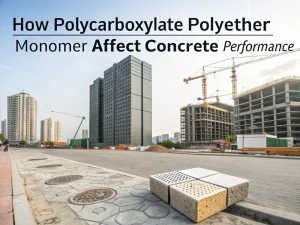Blog
Abstract: In modern architecture, achieving an appropriate balance between the strength, workability, and durability of concrete is crucial. One of the most effective methods to optimize concrete mix proportions is to use plasticizers. But what are plasticizers in concrete, and how do they work?
Plasticizers are chemical admixtures added to concrete during the mixing process to improve workability – concrete can be easily poured, pumped, and completed – without increasing moisture content. Unlike water that dilutes mixtures and weakens concrete, plasticizers enhance fluidity while maintaining or even increasing strength.
Simply put, plasticizers act as a “lubricant” for cement particles, making them easier to slide against each other. Its main function is to increase the fluidity (or “workability”) of concrete without the need for additional water that would weaken its strength.
Plasticizers are classified based on their efficiency in improving processability and reducing moisture content. There are mainly two types:
Ordinary plasticizers (also known as “standard plasticizers”) are the most common type and can moderately improve workability.
Water reduction: usually 5-15% (less water is required for the same processability).
Chemical composition: usually derived from natural materials such as lignosulfonates (by-products of wood pulp processing) or hydroxylated carboxylic acids.
Main advantages:
Improve pumpability and reduce segregation (separation of aggregate and slurry).
Suitable for general buildings that require basic workability.
Common uses: Residential slabs, beams, foundations, and daily concrete mixtures, where ease of pouring is important but high performance is not required.
High-range plasticizers (or superplasticizers) are more powerful and designed for demanding projects that require extreme processability or high strength.
Water reduction: 15-40% (much more effective than ordinary plasticizers).
Chemical composition: Advanced synthetic compounds, most commonly polycarboxylate ether (PCE), can provide excellent dispersibility of cement particles.
Main advantages:
Realize self-compacting concrete (SCC) – a highly fluid mixture that can fill templates without vibration, making it an ideal choice for complex shapes or dense steel bars.
By reducing the water-cement ratio, the strength can be improved to make it suitable for high-performance concrete such as skyscrapers and bridges.
Common applications: high-rise buildings, prefabricated concrete components, bridge decks, and projects where precision and strength are crucial.
Plasticizers have solved several key challenges in concrete construction:
Dosage: usually 0.5-3% of the weight of cement. Overdosing can lead to excessive loss of slump (rapid loss of processability) or segregation, so please follow the manufacturer’s guidelines.
Mixing: It can be added during the ingredient preparation process, either in a blender or after adding. PCE-based high-efficiency water-reducing agents usually perform best when added after initial mixing.
Compatibility: Always use local cement and aggregates for testing, as some plasticizers may react poorly with certain materials such as fly ash or slag.
Plasticizers in concrete are important admixtures that bridge the gap between workability and strength. Whether you need basic improvements for residential projects (ordinary plasticizers) or high-performance solutions for skyscrapers (superplasticizers), they can enhance the versatility, durability, and cost-effectiveness of concrete.

How Polycarboxylate Polyether Monomer Affect Concrete Performance
Blog How Polycarboxylate

How Polycarboxylate Superplasticizer Interacts With Slag In Concrete
Blog How Polycarboxylate